Menus
- Also for beginners: Enduros of the 650 class put to the test
- Comparison test: mid-range enduro – part 2
- Conclusion
- BMW G 650 GS
- Honda Transalp
- Kawasaki Versys
- Yamaha XT 660 R.
- MOTORCYCLE measurements
- Model history
- Japan’s all-rounder
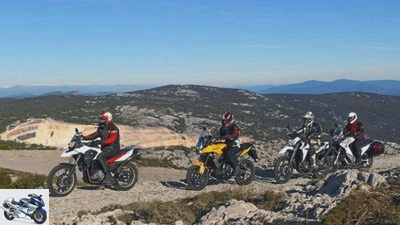
bilski-fotografie.de
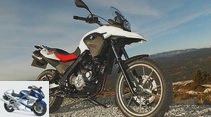
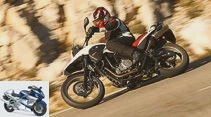
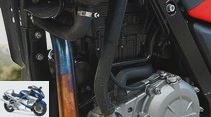
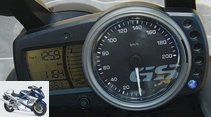
25th photos
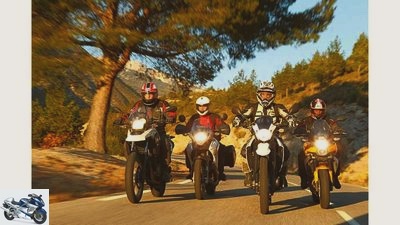
Bilski
1/25
The four mid-range enduros on a test drive in the sunny south of France.
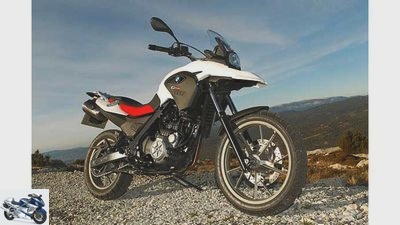
Bilski
2/25
BMW G 650 GS in the classic red and white color combination.

Bilski
3/25
The GS can be circled around the corners in a crisp, precise and stable manner. With the wide handlebar, it is easy to direct.
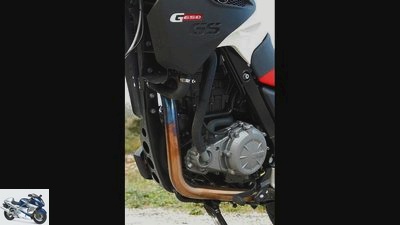
Bilski
4/25
In contrast to the F 650 GS, which is launched with an 800 series twin, the G 650 GS is actually a 650 single-cylinder.
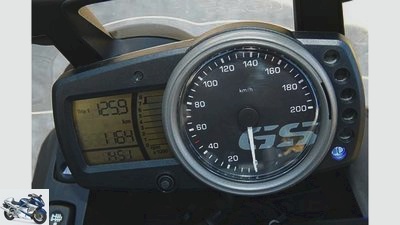
Bilski
5/25
Control lights and speedometer are easy to see. The bars on the LCD tachometer are difficult to read.
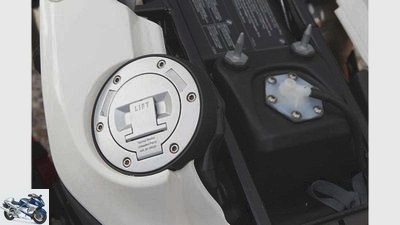
Bilski
6/25
The narrow 14-liter tank is conveniently located under the seat bench.
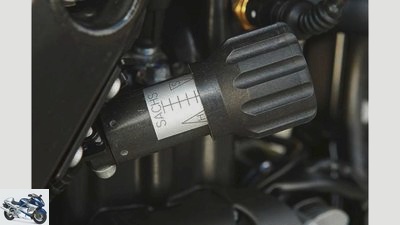
Bilski
7/25
The rotary knob for the hydraulic adjustment of the spring base at the rear is practical – large and easy to reach.
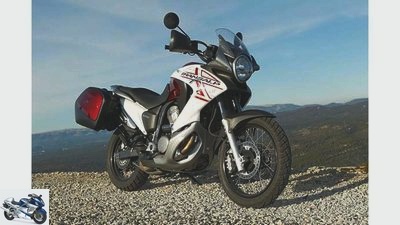
Bilski
8/25
Honda Transalp.
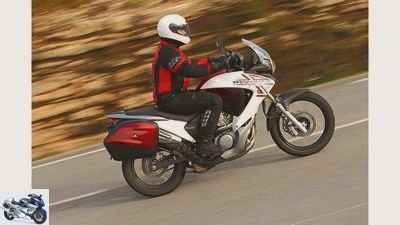
Bilski
9/25
The good-natured queen of displacement of the quartet is a comfortable travel enduro with a high degree of maturity and healthy 62 hp.
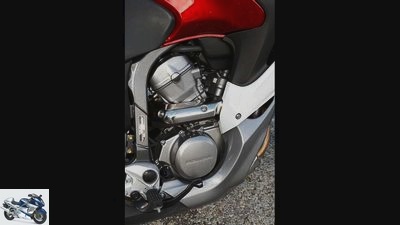
Bilski
10/25
52 degrees cylinder angle as always. But the 680 V2 has four, not three valves.

Bilski
11/25
The directly hinged shock absorber can be quickly adjusted in the spring base and rebound stage. A lot of preload is required for the right balance.
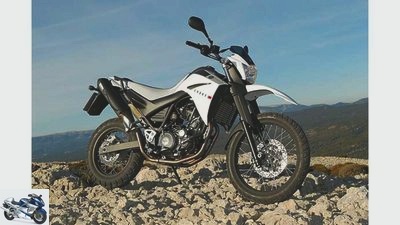
Bilski
12/25
Yamaha XT 660 R..
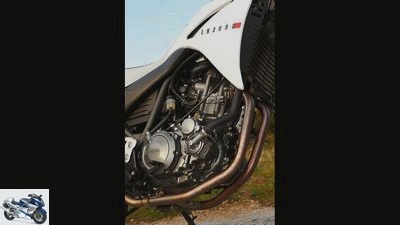
Bilski
13/25
Like the BMW, the XT chases a fat 100 piston through its cylinder, with one millimeter more stroke.
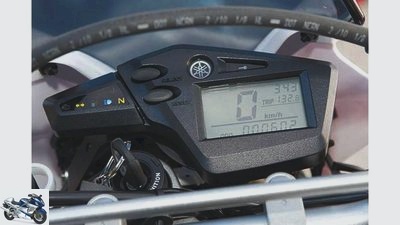
Bilski
14/25
The digital driving and economy cockpit lacks a tachometer. The only luxury is an immobilizer – the French know what matters.
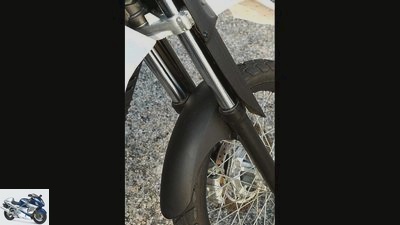
Bilski
15/25
Protectors pulled down to protect the fork tubes effectively.
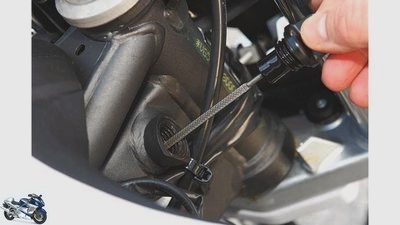
Bilski
16/25
Rather rare sight: the engine oil is in the frame. The dipstick is easily accessible.
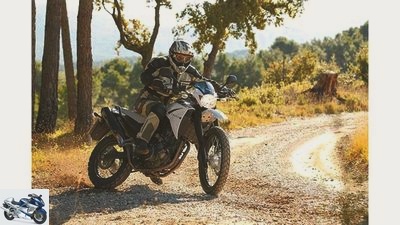
Bilski
17/25
Off-road is fun, but caution is advised: The stainless steel manifolds run under the engine, a protective shield is missing.

Bilski
18/25
These four bikes will take you almost anywhere.
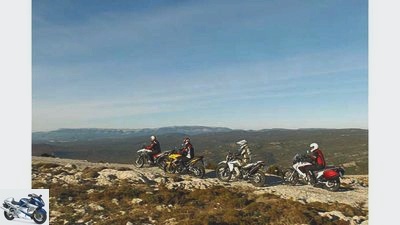
Bilski
19/25
Enduros in their element: Bikes are the most fun in easy terrain.
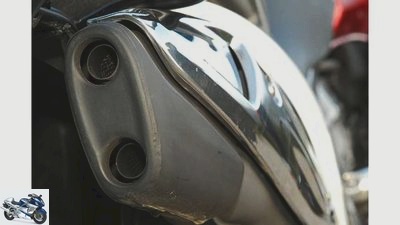
Bilski
20/25
One can argue about the appearance of the muffler.
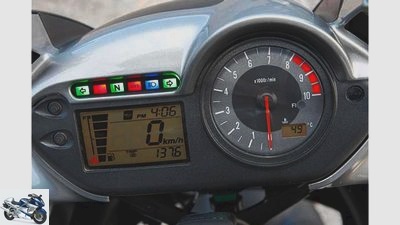
Bilski
21/25
Clear instruments. The engine temperature display is somewhat hidden in the rev counter.
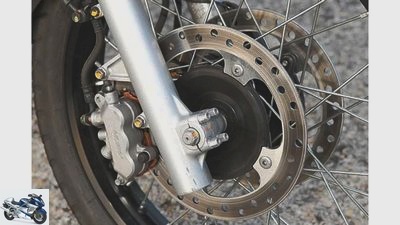
Bilski
22/25
The three-piston calipers and composite system, which can be easily adjusted, are only supported by the ABS version. When you step on the pedal, it brakes at the front.
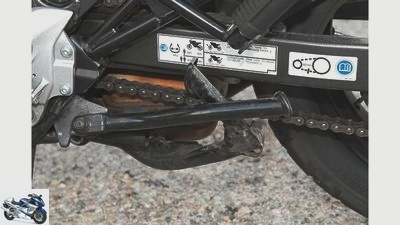
Bilski
23/25
The side stand is in the way of the optional center stand, and jacking it up takes a lot of effort.
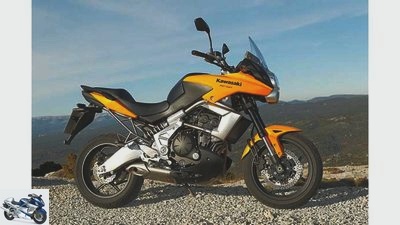
Bilski
24/25
Kawasaki Versys.

Bilski
25/25
The large, white rev counter is easy to read. Not in the picture, but still laudable: both hand levers are adjustable.
Test: mid-range enduro bikes
Also for beginners: Enduros of the 650 class put to the test
With their more or less pronounced enduro qualities, these four representatives of the 650 class enable carefree driving pleasure. Across all concepts, they are very user-friendly and never overwhelm the pilots. Motorcycles that take no offense, even if the road is tough.
The Mediterranean Sea shimmers azure blue in the rear-view mirrors, ocher-yellow rocks contrast with evergreen holm oaks. The ground is covered with hoarfrost and ice flowers. It is a clear, sunny cold on this young morning. Above Toulon, the quartet of four motorcycles screw their way up the 804 meter high Mont Caume. The French aircraft carriers lie down in the harbor like toy boats. The further up you get, the more broken up the asphalt becomes, potholes are lined up with potholes. The terrain suits these all-round talents with more or less pronounced enduro genes. Affordable both-and-machines with real 48 to 66 hp.
E.ine displacement class, "650 plus", a mission: just to be there for your driver. You carry it from the driving test – all with 34 HP if you wish – to the vacation tour, over winding country roads to gravel passages. Like the brand new BMW G 650 GS. As the modern rebirth of the single-cylinder F 650 GS, it carries the most important technical systems from it. Only the letter is there "F." at BMW meanwhile for in-line engines: The current F 650 GS is an 800 twin. Okay, then G – with the engine now assembled by Loncin in China. At least the final assembly of the new BMW entry-level model, base price 6990 euros, takes place entirely in Berlin.
Buy complete article
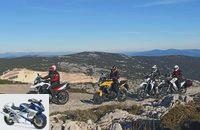
Test: mid-range enduro bikes
Also for beginners: Enduros of the 650 class put to the test
Yamaha XT 660 R occasional detours on unpaved terrain not necessarily crooked. Basic price of the Transalp: 7990 euros.
On the other hand, the Kawasaki Versys, as a second two-cylinder, here with a 650 in-line engine, is more for the craving for quick cornering combinations. A real fun bike concept with the highest performance, 17-inch wheels, street tires and the shortest suspension travel of this comparison, but which are still longer than with street motorcycles, the handlebars are wider. Rudiments of comfortable enduro virtues. Added to this is versatility, suitability for everyday use and a dash of common sense: ABS as standard. This puts the high price of 8195 euros into perspective. If you add 700 euros, there is the Versys, which is fully suitable for travel "Tourer" with pannier rack, painted panniers, multi-adjustable vario lens and hand protectors. It’s just a shame that the payload is only 178 kilograms without accessories.
bilski-fotografie.de
The GS drives crisp, accurate and stable, much better than the old, somewhat spongy “F”. The new one can be easily controlled using the wide handlebars.
The position of the Yamaha XT 660 R is clearly defined. It is the only thoroughbred everyday enduro in this field, the single for dirty work. If the road is not enough, the front 21-inch model with the longest travel and the lowest weight help. The only ones "2-digit" Suspension travel, 225 millimeters at the front, 200 at the rear, allows the XT to take the deep craters just before the summit of Mont Caume in the most relaxed manner. Logical. In terms of suspension technology, the swallowing Yamaha can cope with the most, but thanks to a tight basic set-up, it doesn’t pack its driver in cotton wool. 189 kilograms are a few pounds too much for tough off-road use, the XT is more of a moderate, road-oriented all-round enduro at 6695 euros.
Well, really well, drives the BMW. Sensitive and stable, tighter than you might remember from the old F 650 GS. But not more uncomfortable. The basic concept of the quite conventionally knitted chassis, steel frame with steel swing arm, remained unchanged up to the suspension travel of 170 and 165 millimeters. The new platypus carries well-coordinated spring elements from new suppliers. The G weighs 198 kilograms, four less than the old F, which is very soft at the back. Despite a wealth of additional equipment, ABS that can be switched off, heated grips, and a main stand, this does not mark excessive lightweight construction.
Compared to the premiere in 2007, the shock absorber of the Honda Transalp has less rebound damping, it now rebounds quickly enough. Including ABS, a main stand, a smart Garmin navigation system and a pannier rack including a lacquered, narrow lunch box, the weight of the V2 Moppel climbs to 230 kilograms and the price to 10,444 euros. Undoubtedly quite expensive, the Honda accessories.
bilski-fotografie.de
The good-natured queen of displacement of the quartet is a comfortable travel enduro with a high degree of maturity and healthy 62 hp.
The Kawasaki Versys gets a little out of step on bad terrain. Its 41 upside-down fork filters out a lot, the only one of its kind in this comparison. But the directly hinged shock absorber processes quickly successive strokes moderately. Nevertheless, the Versys also makes it all the way to the top during easy enduro hiking, past a couple of startled stone chickens. The view from the summit is wonderful. In the north-east, snow-capped mountains peel off the horizon, the distant Maritime Alps.
The XT, manufactured by MBK in France, has a home game and is in its element. A scree field calls for a detour on loose ground. Make fun, the snow-white playmobile. Accurate, handy, high. The XT driver perches somewhere in the stratosphere, three feet high. A touch of Dakar, a great feeling. The very hard and narrow bench extends up to the tank. From far ahead you have the wide handlebars and the front wheel under control and you can check the position at any time. Important for enduro riding, comfortable on asphalt, because you can really apply pressure, hold it hard and with relish.
In general, the Yamaha is doing very spartan. It also has to work without adjustable hand levers, main stand and rev counter. The only luxury on board is an immobilizer. The 660 Yamsel alone has to do with a headlight, where even the G 650 GS elevates its two unequally sized lamps to an asymmetrical stylistic device. So what? This dull single-punch XT has something – punch and character.
The Yamaha stew is hearty, hearty. Only an overhead cam, but the full spectrum life. Although the XT-Single slaps the most torque on the crankshaft at low engine speeds, it requires gearshift work because of its low flywheel mass. On what feels like 2,000 tours, he still grudges the chain, comes across strongly in the middle and gets tired again early. The narrow usable speed range demands and encourages active driving. The XT sounds great, muffles muffled from the two steeply raised mufflers. In push mode, we’re driving downhill again, both of them snort heartily.
bilski-fotografie.de
The not very sticky, not very neutral standard tires Dunlop D 221 "G" the Versys hails the line.
When pulling through in the final fifth gear, the Yamaha comes out of its hooves faster than the BMW. More than a second more from 60 to 140 km / h. Yes, the XT even leaves the stout Honda Transalp behind in this exercise. Compliment. Only the Kawasaki Versys is up and away, over the mountains. Its lively, pulsating, torque-optimized counter-rotor surpasses this field. Strong in character, sound and good start. The BMW single can only stand up to the structurally simple Yamaha mallet beyond the 6000 tours. Up to this speed, the GS has the weakest motor. So why all the effort of BMW with double overhead camshafts and the power of the two candles in the 11.5 to one high-compression engine?
The China-Rotax-Single of the G 650 GS is more elastic than that of the XT and can also be moved smoothly at 2000 tours thanks to the larger flywheel. He accelerates much more gently than the clumsy Yamaha. A short translation makes the well-coordinated GS look livelier than it actually is. Nominally only 48 HP peak power meet the EU driving license guidelines valid from 2013. In real terms, the single presses 52 PS as always. The downside: Despite the balancer shaft, it vibrates violently from around 5000 rpm in the handlebar grips, dummy fuel tanks and footrests. At 130 km / h on the Autoroute du Soleil, which is subject to toll here, the soles of your feet are tingling. The small LCD speed estimator in the cockpit can hardly be read. A shift light warns that gear changes are due soon. The old round instrument of the F was better. The easy-to-dose clutch of the 650 is super easy to pull. The single hammered hard from the airbox. Strange: The left of the two large stainless steel mufflers insulates the sound, but leaves the exhaust to the right colleague.
Comparison test: mid-range enduro – part 2
bilski-fotografie.de
Accomodating: It is a pleasure to drive through Provence with the four distinct characters.
The BMW is very economical, needs only 3.4 liters on the country road. It creates almost 100 kilometers more range than the XT. And this even though the GS has only 14 liters of fuel on board – 2.5 liters less than the old F, one liter less than the XT. The XT needs 4.7 liters per 100 kilometers on the country road like the Transalp, the Yamaha rolls first in reserve. The Versys is 4.3 liters. With its 19-liter tank, it can get the furthest, a full 442 kilometers. As usual, the BMW tank is in the frame triangle under the seat. Less volume makes the rear end look less chubby, it slims the waist. Good for driving while standing and when stopping. The bench is still 79 centimeters high. There is a choice of three centimeters higher seating or lowering it to 76 centimeters ex works.
The new G sits much better than before on the blessed F 650 GS. On the old single-cylinder, the handlebar ends, which are cranked far back, were very close to the chest, sat deep, but also quite submissively in the motorcycle. The G’s new 89 centimeter wide and straighter handlebars work wonders. Now it fits, even seasoned drivers feel comfortable on the two-tone seat thanks to the more stretched seating position. The large lever arm allows the 650 to be tilted easily and jaggedly. It wags so loosely through fast alternating curves that the heather wobbles. In curves she remains neutral like a Swiss diplomat. And sturdy even at higher speeds. Great. Apparently the G helps the rear wheel rim widened from three to 3.5 inches.
Change of scene, drive over the Col de l‘Espigoulier. Again and again the street changes direction; you hardly know where the top of the pass will be. At the end, twelve hairpin bends, one on top of the other, convey almost alpine impressions. Some curves are wide, almost like a race track, others narrow and twisted, often not visible. From the rain the day before, some of the bends that have not been lit by the sun are still treacherously damp, the asphalt in the upper third is quite rugged. On the current 1000s, under such conditions, you could sometimes run out of steam. Not so with this uncomplicated quartet.
The Metzeler Tourance of the XT adhere particularly well here, the Tourance EXP of the GS slips a bit more. In addition, thanks to the 90 mm cutting-off wheel on front tires, the XT cuts corners with sharp steering precision. However, the long spring travel makes sensitive braking more difficult. Unfortunately, the standard XT lacks an ABS option, which only the long-distance travel sister Tenere offers. The ABS control intervals on the rear wheel of the GS can be clearly felt pulsating in the pedal. Yamaha and BMW can turn on the palm of their hand, their turning circle is just 4.6 (XT) or five meters (GS).
bilski-fotografie.de
Offroad is fun, but be careful: The stainless steel manifolds run under the engine, a protective shield is missing.
The hour of the two-cylinder strikes uphill and in pillion mode. As their engines offer more reserves, they shake their power more easily out of their sleeves. Well, the Honda is not a hot spur, its four-valve V2 is not very easy to turn. But as a good-natured, honest character, she comes off the clutch as soft as butter, gets in deep down, responds finely to gas commands, goes smoothly from pushing again under load. The indestructible drive does what it should and the gearbox is a fulfillment. Tick, tick, tick, just click through the aisles. The V2 hammers its intake staccato out of the airbox hard. The exhaust with the typical double orifice dampens more. It is made of cheap, black painted steel.
Otherwise, the processing in hidden places on the Transalp looks quite rustic. The test motorcycle comes from Montesa in Spain, while the production of the 2011 model is completely taken over by the Honda Atessa plant in Italy. When adjusting the compression damping at the rear, you can’t see where the screwdriver should reach. The dipstick for the presumably never necessary check of the oil level is annoying (as on the GS and XT). The Honda handlebars are 78.5 centimeters narrow, and their footrests are a tad ahead.
Nevertheless, you immediately feel at home on the Transalp, wonderfully secure behind the hand protectors. No other motorcycle in the quartet conveys so much confidence, offers so much space for a passenger. Only the Honda looks a little more sedate than the others. No wonder it has the longest wheelbase, four inches more than the Versys. Furthermore, her footpegs are the first to furrow over the asphalt. On the Bridgestone Trailwing, the Transalp occasionally folds in bends on its own slightly further in an incline than desired.
The twin disc brakes of the twins throw themselves harder, anchor with a high payload and with long-lasting loads (downhill runs!) Better. The Honda in particular shines in the ABS version, which costs 600 euros extra. Their three-piston calipers at the front are easy to dose, the manual force required is low. There is also compound actuation, when you step on the pedal it brakes at the front, and the best ABS control quality. The double-piston floating calipers of the Versys should bite even more bitingly, their chassis offer a little more sovereignty. The shock absorber appears rather soft. The balance to the great fork is not quite right. Contrary to its fun bike concept, the only real Japanese motorcycle looks more rear-heavy than front-heavy. Feedback such as accuracy suffer from this, despite great handling. In addition, the Versys does not harmonize with the Dunlop D 221 "G". They suddenly cause the worst slides on the wetted track. Not funny at all.
bilski-fotografie.de
Here are the four bikes: The "Funduro" BMW G 650 GS, the road enduro Kawasaki Versys, the Yamaha XT 660 R for off-road and the touring Honda Transalp.
A fun bike needs better rubbers. Why not the famous Dunlop Roadsmart or Sportsmart? Are both given free. The steering precision on the D 221 is a little indifferent. The pilot has to constantly redefine the line. Even the fairly high-seated passenger can feel the driver constantly correcting the course. You sit upright and relaxed behind the fairly high handlebars, which are a little close to your chest, suitable for long journeys, well integrated into the motorcycle. But also a little passive and with a very narrow knee angle, too pointed for long guys.
The Versys, which weighs 211 kilograms, works better in long, wide arches than in tight corners. It’s a shame, as the Versys can only play its trump cards to a limited extent, such as the beautifully stable, asymmetrical aluminum swingarm, the focal point favorable underfloor exhaust, good workmanship and of course the most powerful, inspiring engine. Officially there are the Versys as 2010s-"Jackpot model" for cheap 6,995 euros, with zero percent interest. The real winner at this price and on other tires…
When it comes to equipment like the design of the BMW, there are many fine and not sloppy details. Plus points are the luggage rack with a small, lockable storage compartment, steel-flex brake lines, the ABS, which can be switched off for off-road use, and the easily accessible tire pressure valves located across the spokes. Not to forget the rotary knob on the shock absorber. On the other hand, the main stand squeezed into shape or the turn signal switch under the horn button look cheap. You horn when you turn…
Either way, all four machines are recommended as human friends on two wheels. Ultimately, in the sum of its properties, the Honda just takes first place. Long live the variety of trips!
Conclusion
bilski-fotografie.de
Recently on Mont Caume. These four machines stay calm and bring you up even when the asphalt gets really bad.
1st place: Honda Transalp
In the form of the somewhat difficult Transalp, the most travel-friendly and best-suited concept for pillion rides just barely prevails. And the one with the best brakes.
2nd place: BMW G 650 GS
The single-cylinder F 650 GS used to be bought rationally because it had ABS. The more emotional one "G" Even veterans like cheeky, more adult driving behavior and better posture.
3rd place: Kawasaki Versys
As a versatile overall package, it combines great virtues: an economical, strong and very easy to drive two-cylinder with high seating comfort. With better tires it would be the test winner.
4th place: Yamaha XT 660 R
The XT is really fun to ride, even though it doesn’t mimic a hard enduro. It’s great to roll off with her. But the very low price is offset by poor equipment.
Scoring
Category engine:
The Kawasaki Versys has an engine of a different quality. She dominates the field in all driving performance disciplines. Best acceleration, fastest pulling power, highest top speed. A worthy winner. Only the slow warm-up phase bothers: After a cold start, the short-stroke in-line twin increases the idle speed for an unduly long and high level, well over 2000 rpm. The Honda V2 sets the best marks for transmission and clutch. But it is also child’s play and easy to adjust the coupling on the BMW. The new old GS should be a little brisker in fifth gear, it can only keep the XT in check when accelerating. Both singles vibrate much harder than the two-cylinder. The Yamaha achieved because of high drag and "just" 48 HP little top speed.
Winner engine: Kawasaki
Category chassis:
The chassis of the BMW G 650 GS turned out really well. Particularly handy and stable – in an inclined position as well as straight ahead. Feedback and accuracy are also right. The spring elements of the blessed F 650 GS were not that good. Criticisms? Barely. The boom of the side stand touches down a little early. That’s it too. The Transalp takes a pillion rider with ease. And scrapes across the asphalt even earlier. This class does not generally allow many setting options on the chassis. Because then you can’t go wrong? There is very little that can be varied on the XT, only the rear spring base. At top speed, the high Yamaha enduro becomes unstable. The Kawasaki would do well with a shock absorber with more reserves and, above all, better tires.
Chassis winner: BMW
Category everyday life:
Welcome Home. The Honda crew sits particularly well in front and behind. The highest payload fits there. On the positive side, the Transalp has the best wind protection and the most extensive equipment. The processing of the V2 should be better-"Rally tourers". The Kawasaki is built most nobly. It shines with an extremely long range and adjustable lens. But it lacks a main stand. Despite the small 14-liter tanks, the economical BMW spoils with its large operating range. The GS windshield roars annoyingly and causes turbulence. In return, their stands are easy to operate and the air is easy to control. Well thought out in detail. As much as the XT is used as an everyday mule in southern Europe, more range, greater seating comfort and better equipment would not hurt.
Winner everyday life: Honda
Category Security:
Twins at an advantage. The double disc brakes from Honda and Kawasaki brake better and more persistently, and can be dosed better than the single discs of the single cylinder. Nevertheless, the Transalp sets itself apart from the Versys. Because it can do everything even better, its ABS controls more sensitively. In addition, the Kawa stands up more clearly when braking in an inclined position. At the other end of the spectrum, the Yamaha ends up without ABS. The only advantage of the XT is the ground clearance.
Safety winner: Honda
Category costs:
GS and XT benefit from low maintenance and inspection costs. The 10,000 service intervals from BMW and Yamaha pay off, the Transalp is expensive when it comes to service. The BMW offers a mobility guarantee and low consumption.
Winner costs: BMW
| Max. | BMW | Honda | Kawasaki | Yamaha | Overall rating | 1000 | 604 | 605 | 603 | 530 |
| placement | 2. | 1. | 3. | 4th. | Price-performance note | Top grade 1.0 | 1.8 | 1.9 | 1.8 | 2.5 |
Price-performance winner: BMW / Kawasaki
With full equipment, the small GS also breaks the 8,000 euro mark. So she delivers a head-to-head race with the hardly more expensive Kawasaki. Both offer a lot for the money.
BMW G 650 GS
bilski-fotografie.de
The BMW G 650 GS
engine:
Water-cooled single-cylinder four-stroke engine, two overhead, chain-driven camshafts, four valves, bucket tappets, dry sump lubrication, injection, Ø 43 mm, regulated catalytic converter, 400 W alternator, 12 V / 12 Ah battery, mechanically operated multi-plate oil bath clutch, five-speed gearbox, O-ring Chain, secondary ratio 46:16.
Bore x stroke 100.0 x 83.0 mm
Displacement 652 cc
Compression ratio 11.5: 1
rated capacity 35.0 kW (48 hp) at 6500 rpm
Max. Torque 60 Nm at 5000 rpm
landing gear:
Bridge frame made of steel, telescopic fork, two-arm swing arm made of steel, central spring strut with lever system, front disc brake, Ø 300 mm, double-piston floating calipers, rear disc brake, Ø 240 mm, single-piston floating caliper.
Cast aluminum wheels 2.50 x 19; 3.50 x 17
110 / 80R 19 tires; 140 / 80R 17
Tires in the test Metzeler Tourance EXP
Mass and weight:
Wheelbase 1477 mm, steering head angle 61.9 degrees, caster 113 mm, suspension travel f / r 170/165 mm, seat height * 790 mm, weight with a full tank * 198 kg, payload * 182 kg, tank capacity 14.0 liters.
Guarantee two years
Service intervals 10000 km
Performance variant 25 kW (34 PS)
Colours Red White
price 6990 euros
Price test motorcycle1 7932 euros
Additional costs around 264 euros
* MOTORCYCLE measurements
1 price including: ABS with hazard warning lights (400 euros), heated grips (195 euros), main stand (120 euros), anti-theft alarm system (207 euros), socket (20 euros)
Honda Transalp
bilski-fotografie.de
The Honda Transalp
engine:
Water-cooled two-cylinder four-stroke 52-degree V-engine, two overhead, chain-driven camshafts, four valves per cylinder, rocker arm, wet sump lubrication, injection, Ø 40 mm, regulated catalytic converter, alternator 396 W, battery 12 V / 11 Ah, mechanical actuated multi-plate oil bath clutch, five-speed gearbox, O-ring chain, secondary ratio 47:15.
Bore x stroke 81.0 x 66.0 mm
Displacement 680 cc
Compression ratio 10: 1
rated capacity 44.1 kW (60 hp) at 7750 rpm
Max. Torque 60 Nm at 6000 rpm
landing gear:
Single-loop frame made of steel, telescopic fork, Ø 41 mm, two-arm swing arm made of steel, central spring strut with lever system, adjustable spring base and compression damping, double disc brake at the front, Ø 256 mm, double-piston floating calipers (with ABS: three-piston floating calipers), rear disc brake, Ø 240 mm, single-piston -Swimming saddle.
Spoked wheels with aluminum rims 2.15 x 19; 3.50 x 17
Tires 100/90 19; 130/80 17
Tires in the test Bridgestone Trialwing 101/152
Mass and weight:
Wheelbase 1515 mm, steering head angle 61.9 degrees, caster 106 mm, suspension travel f / r 177/173 mm, seat height * 830 mm, weight with a full tank * 230 kg, payload * 189 kg, tank capacity / reserve 17.0 / 2.4 liters.
guarantee two years
Service intervals 6000 km
Colours White / red, white / blue, black
price 7790 euros
Price test motorcycle2 10,444 euros
Additional costs around 170 euros
* MOTORCYCLE measurements
2 Price including: navigation system (price 940 euros), partially integral brake system with ABS (600 euros), main stand (291 euros), painted case set with holder (823 euros)
Kawasaki Versys
bilski-fotografie.de
The Kawasaki Versys
engine:
Water-cooled two-cylinder four-stroke in-line engine, one balancer shaft, two overhead, chain-driven camshafts, four valves per cylinder, fork rocker arms, dry sump lubrication, injection, Ø 38 mm, regulated catalytic converter, alternator 336 W, battery 12 V / 14 Ah, mechanically operated multi-disc oil bath clutch , Six-speed gearbox, O-ring chain, secondary ratio 46:15.
Bore x stroke 83.0 x 60.0 mm
Displacement 649 cc
Compression ratio 10.6: 1
rated capacity 47.0 kW (64 PS) at 8000 rpm
Max. Torque 61 Nm at 6800 rpm
landing gear:
Steel tubular frame, load-bearing motor, upside-down fork, Ø 41 mm, adjustable spring base and rebound stage damping, two-arm swing arm made of aluminum, spring strut, adjustable spring base and rebound stage damping, double disc brake at the front, Ø 300 mm, double-piston floating calipers, disc brake at the rear, Ø 220 mm , Single-piston floating caliper, ABS.
Cast aluminum wheels 3.50 x 17; 4.50 x 17
Tires 120/70 ZR 17; 160/60 ZR 17
Dunlop D 221 tires tested "G"
Mass and weight:
Wheelbase 1415 mm, steering head angle 65.0 degrees, caster 108 mm, suspension travel f / r 150/145 mm, seat height * 835 mm, weight with a full tank * 211 kg, load * 178 kg, tank capacity / reserve 19.0 / 3.0 liters.
guarantee two years
Service intervals 6000 km
Colours Red Black
Price test motorcycle 8195 euros
Additional costs around 180 euros
* MOTORCYCLE measurements
Yamaha XT 660 R.
bilski-fotografie.de
The Yamaha XT 660 R
engine:
Water-cooled single-cylinder four-stroke engine, an overhead, chain-driven camshaft, four valves, roller rocker arm, dry sump lubrication, injection, Ø 44 mm, regulated catalytic converter, alternator 291 W, battery 12 V / 8 Ah, mechanically operated multi-plate oil bath clutch, five-speed gearbox, O-ring Chain, secondary ratio 45:15.
Bore x stroke 100.0 x 84.0 mm
Displacement 660 cc
Compression ratio 10.0: 1
rated capacity 35.3 kW (48 hp) at 6000 rpm
Max. Torque 58 Nm at 5250 rpm
landing gear:
Single-loop frame made of steel, telescopic fork, Ø 43 mm, two-arm swing arm made of steel, central spring strut with lever system, adjustable spring base, front disc brake, Ø 298 mm, double-piston floating caliper, rear disc brake, Ø 245 mm, single-piston floating caliper.
Spoked wheels with aluminum rims 1.85 x 21; 2.75 x 17
Tires 90/90 21; 130/80 17
Tires in the Metzeler Tourance test
Mass and weight:
Wheelbase 1505 mm, steering head angle 62.0 degrees, caster 107 mm, suspension travel f / h 225/200 mm, seat height * 870 mm, weight with a full tank * 189 kg, payload * 178 kg, tank capacity 15.0 liters.
guarantee two years
Service intervals 10000 km
Colours Blue White
Price test motorcycle 6695 euros
Additional costs around 165 euros
* MOTORCYCLE measurements
MOTORCYCLE measurements
Drawing: archive
The performance diagram of mid-range enduro bikes.
Paradoxical parameters. Despite the slight displacement advantage, the Honda does not have more power and torque than the rest of the field at any speed. Instead, the Kawasaki Versys trumps the field at around 4000 and beyond the 5500 tours. The XT 660 R trumps up to almost 4000 rpm and 5000 rpm, but is rather tough at the top with 48 hp. Measured against the subjective driving experience, the curves of the BMW appear surprisingly narrow-chested. After all, it makes a real 52 instead of the promised 48 hp.
Maximum speed (manufacturer information):
| Manufacturer | Km / h | BMW | 170 |
| Honda | 172 | Kawasaki | 185 |
| Yamaha | 160 |
Acceleration:
| Manufacturer | 0-100 km / h | 0-140 km / h | BMW | 5.1 | 11.3 |
| Honda | 5.1 | 10.0 | Kawasaki | 4.1 | 8.3 |
| Yamaha | 5.2 | 11.5 |
Draft:
| Manufacturer | 60-100 km / h | 100-140 km / h | 140-180 km / h | BMW | 5.7 | 7.5 | – |
| Honda | 5.6 | 6.8 | – | Kawasaki | 4.8 | 5.5 | 10.5 |
| Yamaha | 5.3 | 6.8 | – |
Fuel consumption (country road):
| Manufacturer |
Liters / 100 km |
| BMW |
Normal 3.4 | Honda |
Normal 4.7 |
| Kawasaki |
Normal 4.3 | Yamaha |
Normal 4.7 |
Theoretical range (country road):
| Manufacturer |
Km |
| BMW |
412 | Honda |
362 |
| Kawasaki |
442 | Yamaha |
319 |
Model history
The mid-range enduro bikes in this comparison test all look back on a long, successful line of ancestors.
archive
BMW F 650: Trendsetter with Rotax engine and chain drive. As a very affordable entry-level model, it attracted new buyers to BMW
The "Funduro" F 650 appeared in 1993 as a hybrid of enduro and road machine, with 19-inch front wheel, spoked wheels and high, wide handlebars. It heralds a new era at BMW: It is built by Aprilia, its 48-hp single-cylinder comes from Rotax and has a chain drive. In 1997 the street version ST appeared. When production moved to Berlin in 2000, the F 650 GS came as a completely new model with injection, G-Kat and optional ABS, which was exclusive to the middle class at the time. Only the F 650 GS Dakar corresponds to a classic enduro, with longer suspension travel, coarse tires and a 21-inch front wheel. In 2001 the timing belt-driven "Scarver" F 650 CS from the family. In 2007 the successor series G 650 appears, with a single cylinder now assembled in China. From 1993 to 2010 BMW produced a total of 185,000 copies of all F-650 and G-650 models. On January 1, 2010, 48,794 copies were registered in Germany.
Japan’s all-rounder
archive
Honda XL 600 V Transalp: Honda crossed 21-inch front wheel with a deeply mounted mudguard, fairing and rather tight suspension travel.
1987 the Honda XL 600 V unites opposites. Heavy for an enduro, long-legged for classic tourers. But that from Honda "Rally tourer" The baptized concept asserts itself, combines the advantages of both types. 50 HP are enough, the reliability of the 52-degree V2 is legendary to this day. Constant model maintenance keeps the "Tranny" At the height of the time. 1997 the production is relocated to Italy, the processing quality initially sinks to a low point by Honda standards. In 2000 the newly constructed 650er Transalp comes. Between 1987 and 2000, the 600 series was sold around 20,000 times in Germany alone; at the beginning of 2010, 16,827 were registered.
archive
Kawasaki KLE 500: hermaphrodite. Unlike today’s Versys, the KLE still had a large front wheel. But also a row twin.
Kawasaki’s KLE 500 received as a two-cylinder-"Road enduro" the engine of the GPZ 500 S. Despite throttling from 60 to 50 HP for more torque, it only revs up properly from 5000 revs. Despite the 21-inch front and 17-inch rear, the all-rounder is not intended for real gravel robbers. In 1997 a U-Kat followed, in 2005 a complete restyling; of the 10,237 copies sold in Germany, 6,181 were registered at the beginning of 2010.
archive
Yamaha XT 600: It inspired longings, turned on and drove to Africa and back as Tenere. The 600s became a legend.
In 1983 the XT 600 Z Tenere appears, a desert ship with a 46-horsepower stew, rally design and 23-liter tank. A dream! In 1984 it was followed by the XT 600 with an 11 liter tank and only kick starter. The XT 600 is becoming increasingly civil, from 1990 onwards it has a reduced seat height, slightly shorter spring travel and an optional electric starter. From 1991 the Tenere rode into the desert as the XTZ 660 with a five-valve head, 48 HP, water cooling and a lower seat height. In 2004 the XT 660, including a Supermoto version, took over. The 600 and 660 XTs will find a total of 53,864 buyers in Germany by 2010; the KBA last counted 24,733 copies.
Related articles
-
Suzuki, Honda and BMW travel enduros put to the test
Fisherman 23 photos faceCatcher.com 1/23 Mid-range travel enduros from Suzuki, Honda and BMW in a comparison test. faceCatcher.com 2/23 Procedure? No, U…
-
Comparative test four-cylinder middle class
Gargolov comparison test four-cylinder middle class The Simple Things Basically it’s very simple. Four cylinders in line are the most popular …
-
Comparison test motorcycles 800 class
Rivas 56 pictures Rivas 1/56 Rivas 2/56 Ouch: The gear lever and main stand already hit the ground at medium inclines. Rivas 3/56 Practical: handwheel on …
-
The enduro mega test: travel enduros up to 1200 cm³
44 pictures 1/44 The final opponent of BMW, the Triumph Tiger 800 XC. 2/44 Wide handlebars, fat motors, big …
-
Artist comparison test middle class Honda Hornet S Kawasaki ZR-7 S Suzuki GSF 600 S Bandit Yamaha FZS 600 Fazer Born to be mild Four days, 1913 …
-
The enduro mega test part 1: travel enduros up to 800 cm³
Photos: Jahn 29 photos Jahn 1/29 Magnificent panorama of the Pyrenean peaks around the Col d’Ares. Jahn 2/29 Fantastic bikes, fantastic weather. Jahn …
-
Comparison test of sporty enduros
Comparison test, KTM 620 LC 4, Suzuki DR 650 SE, Triumph TT 600 Sporty Enduros Too good for tough sport use and too rough for everyday life: KTM 620 LC4 …
-
Comparison test of travel enduros
Jahn comparison test of travel enduros, BMW F 650 GS, Honda Transalp, Kawasaki Versys 650, Suzuki V-Strom 650 / XT We are then away towpath instead …
-
Comparison test travel enduros
Jahn comparison test travel enduros, BMW R 1200 GS Adventure, KTM 990 Adventure, Moto Guzzi Stelvio travel enduros Their martial look promises …
-
Big travel enduros put to the test
36 photos 1/36 BMW R 1200 GS Rallye, Honda VFR 1200 X Crosstourer, Triumph Tiger 1200 XCA and Yamaha XT 1200 ZE Super Tenere in…